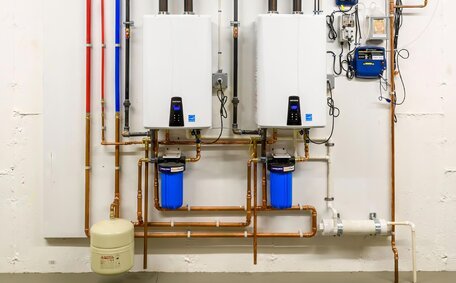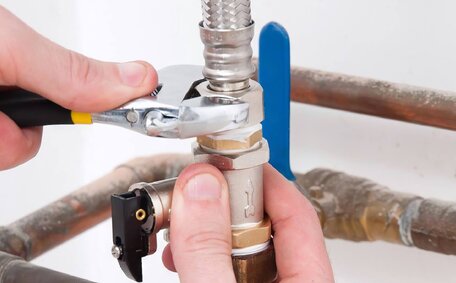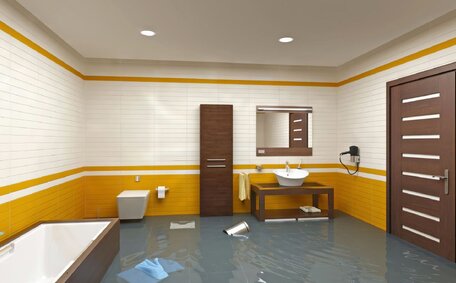Introduction to Pipe Blockages from Grease & Food
Residential and commercial properties in Bella Vista, Sydney often encounter blocked drains. Grease, fats, oils, and food scraps often make their way down sinks and drains, coating pipes which a blocked drain can severely impact over time. An accumulation of these remnants can narrow pipes and restrict water flow, leading to clogs and backups.
At Bella Vista Plumbing, we can get calls to clear your blocked drain and sewers containing thick deposits of congealed greases, fats, and old food particles. Unchecked, these obstructions can halt drainage, creating foul odours, leaks, and unsanitary conditions.
Fortunately, pipe relining presents an effective solution to recurrent clogs by addressing the underlying issues of debris accumulation in drains. Pipe relining, a trenchless technology, creates a protective layer within your pipes, eliminating the need for excavation or total replacement. The rugged, corrosion-resistant relining prevents future blockages by smoothing out cracks that collect buildup, such as tree roots, inside drains.
This article delves into the causes of grease and food blockages, warning signs of drain problems, and how Bella Vista Plumbing’s Sydney drain relining can shield your plumbing against repeated clogs.
Causes of Grease and Food Buildup
Daily tasks such as washing dishes and disposing of cooking oil, fats, and meat scraps contribute to grease and food accumulation, leading to compromised pipes and clogged drains. Gradually, drains can narrow and clogs form.
They congeal as they cool, forming thick masses that collect debris. Gurgling sounds, foul odours, and slow drainage indicate grease and food buildup in sinks.
Impact of Grease and Food Buildup
Over time, grease and food buildup detrimentally affects drainage systems, a problem remedied effectively by pipe relining solutions. As deposits accumulate, pipes can become blocked, steadily decreasing water flow until a full blockage occurs. This can lead to a number of inconvenient, costly and hazardous consequences.
Partial clogs often result from oil, grease, and food debris, causing noticeable problems such as:
- Slow draining water
- Gurgling noises
- Foul sewage odours
- Leaking pipes
Without prompt intervention, these problems can escalate to full pipe blockages. Full blockages can:
- Completely stop water flow, resulting in backups
- Lead to necessary drain repair due to overflows of water, sewage and filth
- Create unhygienic conditions and health risks
- Damage plumbing infrastructure
- Require costly emergency repairs and replacements in the event of severe blockages
Commercial kitchens face added risks from grease and food buildup, including fire hazards and contamination, requiring regular draining cleaning and potentially leading to business loss during repair closures.
It’s crucial to take care of minor clogs before they escalate into major blockages necessitating pipe repairs or replacement. This is precisely what needed done to break down potential clogs and preserve the integrity and lifespan of your drains.
Preventing Grease & Food Buildup
Numerous effective strategies can prevent blockages in drains caused by grease and food:
Proper Grease Disposal
- Never pour fats, oils, or grease down the drain; instead, let them cool and dispose of them in the rubbish bin.
- Use sink strainers to catch food waste and ensure toilet paper is used in appropriate amounts to prevent clogs.
- To prevent a blocked toilet, consider installing a grease trap inline under the sink to catch oil and grease before they enter the drainage system.
- Clean grease traps regularly as per manufacturer’s instructions.
Careful Food Preparation & Cleaning
- Scrape and wipe plates and cookware before washing to remove fats oils and food debris.
- Utilise a sink filter/guard to catch stray scraps and grease fat from entering pipes.
- You can use garbage disposal units sparingly, as they can send debris on its way into pipes.
- Regularly use a mixture of baking soda, vinegar, and boiling water or enzyme cleaners to break down mild grease and oil buildup.
Pipe Relining
Pipe relining essentially creates a smooth, protective lining preventing the build-up inside damaged drains and sewers. This waterproof barrier was very effective and meticulous in ensuring that pipes are safeguarded against future grease, fat and food particles from sticking to cracks and corroded areas that tend to collect debris.
Relining can help solve root causes rather than temporarily unblocking symptoms. By shielding the space inside your drains, it provides lasting prevention against blockages.
Grease Traps: Function and Maintenance
Grease traps play a crucial part in safeguarding your sewer drain by capturing fats, oils and grease (FOG) waste from kitchen sinks before they can cause blockages in your sewer drain. Installed inline under sinks and linked to stormwater drains, these traps use gravity to segregate greases into a reservoir tank for periodic removal.
Household grease interceptors collect fat deposits from dishwashing and food preparation and should be kept clear of flushed sanitary products. They can easily be cleaned every 2-3 months using hot water and degreasers to flush out oil buildup.
Commercial kitchens need frequent maintenance by a professional plumber due to larger traps that collect substantial amounts of fat waste. Professional pipe patching and cleaning of a drain can every 2-4 weeks is crucial to prevent blockages from years of grease accumulation.
To ensure efficient operation of your grease traps, follow these guidelines or consult with professional drain plumbers:
- Never dispose of cooking oils or fats down the sink, as they can damage your drainage system and lead to blockages. Allow to cool before discarding.
- Dry wipe plates and pans to remove fats before washing up.
- Use strainers and guards to catch food particles from entering drains.
- Clean traps regularly to flush out grease and prevent build up in the drain pipe between pump outs.
- Make sure pump outs and replacements are completed on schedule.
Consistent grease trap maintenance prevents blockages to keep sewage flowing in Bella Vista plumbing systems.
Pipe relining is an innovative trenchless technology for restoring damaged plumbing and gas drainage pipes without excavation. It involves installing a durable epoxy resin lining inside the existing pipe, a step to clear blocked drain and create a smooth, protected "pipe within a pipe".
This seamless inner lining repairs cracks and holes in older pipes where blockages from soap scum and other debris form. It protects even old clay pipes’ inner surface to prevent future buildup of greases, fats, roots, and debris. Pipe relining ensures that any intrusive roots can be effectively managed, allowing old pipes to be revived rather than replaced.
Advantages of Pipe Relining
Compared to traditional pipe replacement, pipe relining offers many benefits:
- Less invasive with no digging or destruction to landscaping
- Significantly less disruption to properties and infrastructure
- Restores pipe integrity and water flow without removal, no matter the severity of the damage
- Long-lasting solution preventing recurrent blockages
- Cost-effective and time-efficient solution
The Pipe Relining Process
Our very professional technicians use high tech equipment to carefully install resin linings inside compromised pipes. The basic steps we highly recommend include all your relining solutions:
- Inspecting pipes with drain cameras to locate damaged sections
- Cleaning and preparing pipe interiors with instruments like a drain snake for relining
- Installing resin-saturated lining with compressed air
- Curing the lining using water or steam pressure to ensure it adheres to the pipes
- Finishing and reconnecting lined pipes back into the drainage system
In just one day, the pipes your home shelters can receive comprehensive restoration, ensuring lasting defence against leaks, breaks, and blockages through trenchless pipe relining.
The Pipe Relining Process
At Bella Vista Plumbing, your plumber brings trust and expertise, with our professional, qualified plumber utilising specialised equipment to meticulously reline damaged pipes, averting issues such as a blocked sewer across homes and buildings in Bella Vista and neighbouring areas. The pipe relining process allows existing pipes to be restored from the inside out in just one day.
The fundamental steps of pipe relining involve:
- Inspecting pipes using a drain camera to identify damaged sections requiring restoration.
- Cleaning and preparing the interior pipe surface so relining can properly adhere.
- Saturating a durable epoxy resin lining and installing inside the pipes using compressed air to spread seamlessly.
- Curing and hardening the lining using steam pressure to form a smooth, protective inner barrier.
- Finishing relining for full integrity before reconnecting pipes back into the drainage system.
The outcome is a rejuvenated piping system that delivers enduring defense against leaks, cracks, tree root encroachment, and collapsed walls, as well as the accumulation of fats, oils, and grease. Pipe relining improves resistance to future grease-related obstructions and helps clear blocked pipes and significantly extends drainage lifespan without digging or replacement.
Our non-invasive pipe relining method not only prevents expensive emergency repairs but also minimises disruption to your property. The service does not generate any excessive mess or noise that would impact homes and businesses.
For properties across North Shore and Greater Sydney that need rapid whole-pipe restoration without undergoing pipe replacement, Bella Vista’s expert service, conducted by Sydney plumbers, is prompt and efficient.
Other Preventive Strategies
In addition to pipe relining, Bella Vista Plumbing suggests ongoing preventive strategies to minimise grease and food accumulation in your plumbing system.
Regular Maintenance
- Make it a weekly routine to flush your kitchen sink drains with hot water to liquefy fats and dislodge debris.
- Monthly, pour boiling water down your drains, including basins, showers, and floor wastes, to prevent items from being flushed down and to maintain water seals.
- Every three months, it’s essential to clean grease traps with high-pressure water as advised by the manufacturer.
- Schedule annual drain inspections with a professional using a CCTV drain camera to promptly identify any potential issues.
Daily Precautions
- Never pour fats, oils, or greases down sinks or toilets to avoid drain blockages. Allow to cool completely before discarding in the garbage.
- Use sink strainers to gather food scraps in your kitchen for composting or disposal.
- Conserve all cooking fats, meat juices, and food remnants in containers for appropriate disposal, rather than rinsing them into your drains.
- Avoid using strong chemical drain cleaners which can damage pipes.
Instilling ongoing preventive habits can keep your drains clear of grease and food particle accumulation over time. This prolongs pipe lifespan and drainage system integrity for homes and businesses around Bella Vista.
For advice on maintaining your property’s drainage system or for 24-hour assistance with pipe inspections, CCTV drain imaging, and plumbing services, contact the experts at Bella Vista Plumbing on 1300 349 338.






